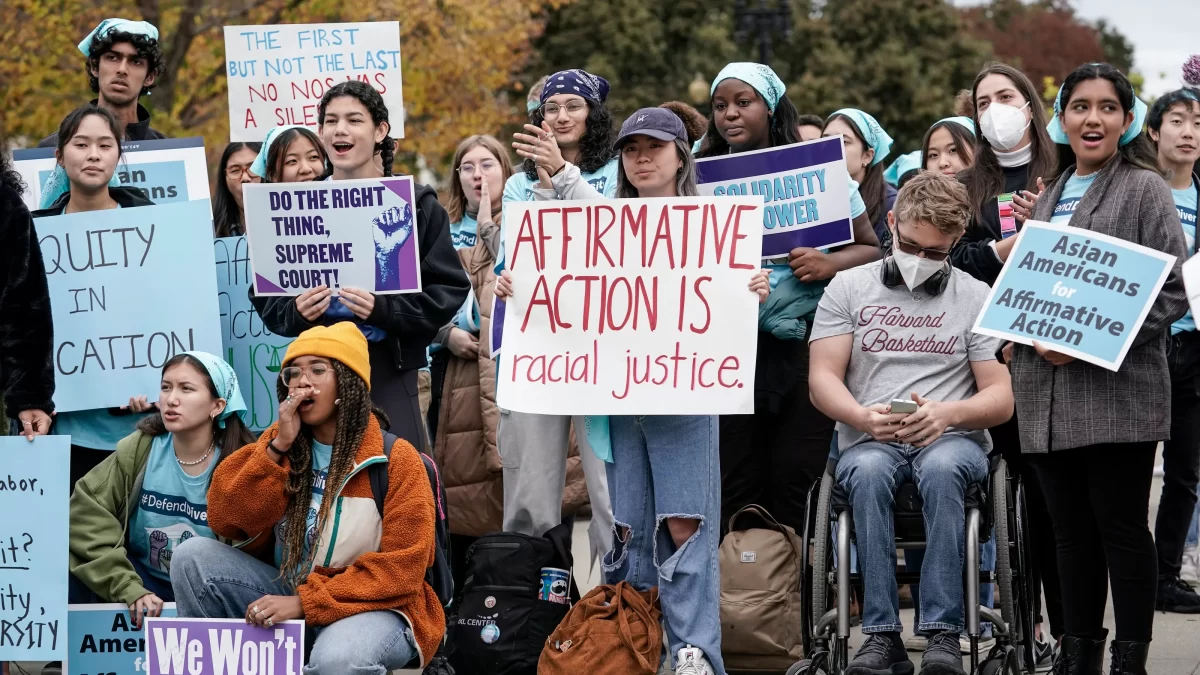On June 29, 2023, the Supreme Court effectively ended affirmative action in college admissions. They declared that “race cannot be a factor and [are] forcing institutions of higher education to look for new ways to achieve diverse student bodies,” (edweek).
Affirmative action is a government program “favoring individuals belonging to groups regarded as disadvantaged or subject to discrimination,” (Oxford Languages). The key aspect of affirmative action is its ability to provide special access to opportunities, typically in education and employment, to members of groups who have previously been discriminated against. College admissions used race as a factor because it allowed for “equality of opportunity” and created a more diverse student body to represent the American population; a melting pot of different races.
Although affirmative action exists to provide “equality of opportunity,” many find affirmative action a harmful program. Before the Supreme Court ended its ban, affirmative action was fundamentally flawed. Strictly looking at college admissions, qualified applicants find themselves rejected from top-tier colleges because these colleges are attempting to meet a quota and reject overqualified applicants for marginally qualified applicants who meet their diversity criteria.
In Students for Fair Admissions Inc. v. President and Fellows of Harvard College, 600 U.S.___ (2023), the deciding case of affirmative action’s current status was brought to by an Asian rejected from Harvard, blaming affirmative action. This is not an anomaly among college applicants. There have been many applicants and court cases questioning affirmative action’s usefulness; in the end, under the Equal Protection Clause of the Fourteenth Amendment, affirmative action was found unconstitutional.
According to BestColleges, 52% of Asians and 57% of whites disapprove of affirmative action compared to only 29% of African Americans and 39% of Hispanics. The groups most impacted by affirmative action are not the groups benefiting from it but the groups negatively affected by it. Asian Americans and white prospective students are more likely to be rejected for their race because colleges are meeting the quota of diversity. Since a majority of applicants tend to be Asians and white students, they are rejected more so. It is not a far-fetched assumption that Asians and whites who see themselves as overqualified believe affirmative action is preventing them from admission into top-tier colleges such as Harvard.
Statistics from wbur and Harvard’s demographic data show that Harvard has become more diverse since Class of 2010. However, another graph shows that most Harvard students come from the nation’s richest families. Around 70.3% of Harvard students come from families in the top 20%, of that, around 15.4% come from the top 1%. Although affirmative action may cause minorities to believe that they have a chance, reality shows that colleges like Harvard may only want scholar’s money.
Malcolm X states, “If you stick a knife in my back 9 inches and pull it out 6 inches, there’s no progress. If you pull it all the way out, that’s not progress. The progress is healing the wound that the blow made[…]They won’t even admit the knife is there.” The Supreme Court refuses to acknowledge the underlying problems with affirmative action; college admissions abused this program to hide their admissions based on legacy. Affirmative action assists disadvantaged students in recovering from discrimination. However, affirmative action is used as an excuse for colleges to earn more money. Colleges are not plucking scholars with grade point averages (GPAs) significantly lower than the margin to add diversity, rather, they are picking minority scholars who can pay for their full tuition with less financial aid.
If the Supreme Court truly hoped to reach meritocracy, they wouldn’t have ended affirmative action, they would’ve prevented legacy admissions. Legacy admissions refer “to a boost in a prospective student’s odds of admission to a college just because the applicant is related to an alumnus,” (usnews.com). Legacy admissions can also extend to donor-related applicants. Statistics from Forbes show Harvard’s overall acceptance rate was 3.2%, donor-related applicants had a 42% admission rate, and legacy admissions had a 34% acceptance rate. College admissions can factor in one’s previous history of donations prior to accepting them. Factoring in donations and legacy for college admissions is an attempt to draw more money from families. This practice gives a heavy advantage to wealthy applicants related to donors because colleges value the potential profit from them over more deserving applicants. Ending legacy admissions is a requirement to achieve education equity because it is the biggest roadblock for scholars to be admitted into higher education colleges.
The Supreme Court not ending class-based admissions shows the Court is on the side of the elite capital. Affirmative action was not the reason minority races did not enter colleges, rather, it was because their family was not rich enough. College admissions ultimately want their applicants’ money. By accepting scholars with a legacy status, the college does not offer more financial aid. In return, the college makes a profit off their tuition. If the applicant is wealthy, this becomes a small problem and benefits both the applicant and the college. The applicant is accepted into a prestigious school while the college makes a profit. It creates a continuous cycle where the rich and corporations continue to benefit each other while the less wealthy are left to work harder.
Legacy students take the place of more deserving students. The government does not prevent legacy admissions because of the capitalist economy the U.S. is based around. Colleges are private corporations, so the government does not interfere with their admissions process. The government’s ignorance of college admissions does not offer qualified applicants the equity they deserve, especially when those applicants have a less fortunate background.
To prevent legacy admissions, the government should be more active in the college admissions process. The process should be based on offering equal opportunity to all applicants. Wealth should not be a factor. Admissions should focus on one’s applicableness to the college. Affirmative action should still be prevalent to offer equal opportunity to minorities. Colleges should become a diverse populous that reflects different educational backgrounds, not a farm for colleges to milk money. The government must make these reforms to the college admission process because providing equal opportunity is essential to less fortunate students.







